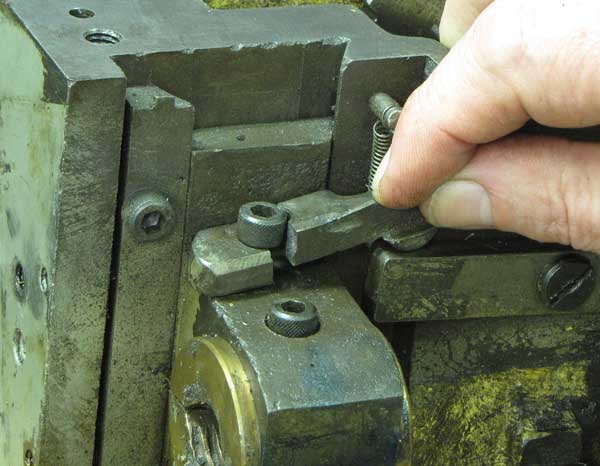
Samson's Travail:
This time it's a
Carriage Problem
© Frank Ford, 2009; Photos by FF
TechShop's smaller lathe, the Samson 11-inch, is one of the hardest working tools in the machine room. Along with hard work has come the occasional hard break - in this case it was the pawl that actuates the lockout for the gear shift when the half-nut is engaged on the lead screw. How it broke is a mystery at this point, because nobody knows quite when it happened or who was using the machine at the time. Maybe it fatigued and broke on its own, since it was a bit flimsy and made of cast iron with a mighty big hole drilled through it. Maybe somebody leaned on the half-nut lever too forcefully.
Regardless, here's the result:

Clearly a new part was the only answer, so I found a piece of hot-rolled mild steel, squared it up on the mill, drilled a mounting hole and made the appropriate cuts to fabricate the new pawl:

Making it of steel rather than cast iron assures me that if leaned on too hard, maybe it might bend a bit, but it won't break the way the old one did.
A few strokes with a file, and I had a nice rounded bearing surface for the end:

Here's the finished product - a good deal stronger than the original:

Simple enough to screw it back in place:

By far the biggest part of this job was disassembly, cleaning and reassembly. I figured it wasn't all that interesting so I didn't take photos of that stuff.
Here's the sheared-off roll pin that secured the carriage Z-axis drive gear to the shaft:

It seems clear enough that once the half-nut lockout pawl was broken the carriage could have been locked onto the lead screw while the Z-axis feed was engaged. The result would have been some serious broken parts without the safety feature of this little shear pin giving way. It would have required full disassembly of the rest of the gear train to get that big gear out of the housing, so I decided to work with it in place.
The original roll pin was metric, of course, and I thought it would be good to clean up the hole and replace the pin with the closest SAE size, which was 7/32" in diameter.
Over on the milling machine I spent some time aligning the parts and the hole to the axis of spindle rotation. Then I passed through the hole with a #3 drill, followed by the 7/32" reamer to get a nice clean hole:

Here's the new roll pin in place:

An hour later, and ol' Samson was humming along nicely:
